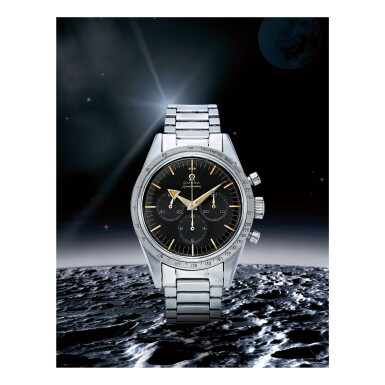Auctions
Buy Now
Collectibles & More
Books & Manuscripts
Omega Speedmaster: To the Moon and Back | Celebrating 50 years since Apollo 11
Omega Speedmaster: To the Moon and Back | Celebrating 50 years since Apollo 11

Auction Closed
July 19, 08:01 PM GMT
Estimate
150,000 - 200,000 USD
Lot Details
Description
OMEGA
SPEEDMASTER REF 2915-1 'BROAD ARROW'
A STAINLESS STEEL CHRONOGRAPH WRISTWATCH WITH BRACELET, MADE IN 1958
Dial: black
Caliber: cal. 321 manual winding movement, 17 jewels
Movement number: 15'996'671
Case: stainless steel
Closure: stainless steel Omega bracelet with folding clasp, endlinks stamped 6
Dimensions: 38 mm diameter, bracelet circumference approximately 185 mm
Signed: case, dial and movement
Accessories: Accompanied by an Extract from the Archives confirming date of manufacture on December 24, 1958 and subsequent delivery to Mexico.
The Omega Speedmaster was introduced in 1957 as an additional purpose built watch sport watch featuring a chronograph to time events. It shared the Broad Arrow hands, case shape and screw down back with its counterparts, the Seamaster and Railmaster, and complemented the lineup alongside the other tool watches made for the divers’ and the engineers’. This was the trend of the era: making robust tool watches for actual applications during work or sport. The 2915 thus lived alongside the 2913 (Seamaster) and 2914 (Railmaster) in DNA and utility.
If viewed next to similar watches from other brands, several aspects of the Speedmasters’ design set it apart from the rest. The fixed exterior bezel with tachometer, as opposed to printing on the dial, making reading the scale far easier and clearer to the user. While the 1940s featured many chronographs with snap backs and square pushers, the Speedmaster had a screw down back (complemented by a dust cap) and round pushers, providing resistance to water and dust and allowing the user to activate the chronograph with more ease and definition. The distinct large Broad Arrow hands with luminous materials eased legibility in the dark and at brief glances.
Examples of the 2915 also vary in small details. The steel bezel, on the 2915-1 and -2 in particular, were phased to a black aluminum insert in the 2915-3 and later references. The Broad Arrow hands were eventually replaced with Alpha hands and later references adopted the baton hands that are still used today.
In all, the evolution of the 2915 created a groundwork for a line of chronographs which has remained lightly changed over its 60 year lifespan. The watch that was worn for Walter Shirra’s first venture to space in 1962, a reference 2998, and eventually adopted by NASA for official use in 1965, a reference 105.003, remained almost identical in components and aesthetics to the 2915-1 and the modern lyre lug asymmetric Speedmaster.